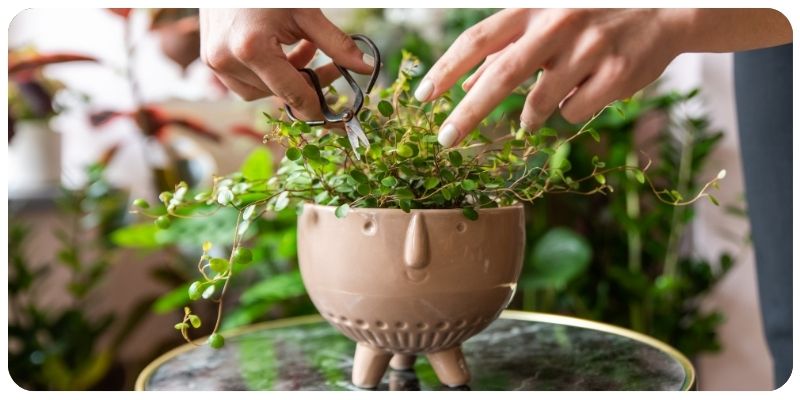
How to Prune Indoor Plants for Maximum Growth
Pruning is an essential technique to maintain the health and appearance of your indoor plants. When done correctly, it promotes new growth, improves airflow, and ensures your plants stay vibrant and strong. This guide will walk you through the best pruning practices to encourage maximum growth in your houseplants.
1. Why Prune Indoor Plants?
Pruning is more than just a cosmetic fix. It helps remove dead, damaged, or diseased parts of the plant, preventing the spread of disease. Pruning also encourages new growth by redirecting the plant’s energy to healthy leaves and branches. Regular pruning can result in fuller, healthier plants.
Benefits of Pruning
- Encourages New Growth: By removing old or damaged growth, pruning stimulates new leaves and branches to form, leading to a fuller plant.
- Improves Airflow: Pruning reduces overcrowding, which improves airflow and helps prevent fungal diseases that thrive in humid conditions.
- Maintains Shape: Regular pruning allows you to shape your plant as it grows, keeping it compact and aesthetically pleasing.
- Prevents Disease Spread: Removing diseased or dead parts of the plant helps prevent the spread of infections to other areas.
2. Tools You’ll Need
Pruning is a simple task, but using the right tools ensures clean cuts and minimizes damage to the plant. The following tools are recommended for indoor plant pruning:
- Pruning Shears: Sharp, clean pruning shears are ideal for cutting through stems and branches without crushing them. Regularly clean and sterilize the shears to avoid transferring diseases between plants.
- Scissors: For smaller or delicate plants, a good pair of sharp scissors will work for cutting leaves and soft stems.
- Gloves: Some plants, like cacti or those with irritant sap, may require gloves to protect your hands while pruning.
- Isopropyl Alcohol: Use alcohol to disinfect your pruning tools before and after each use to prevent the spread of plant diseases.
3. How to Prune Your Indoor Plants
Now that you’re equipped with the right tools, it’s time to start pruning. The key is to prune strategically, removing the right parts of the plant to promote growth while maintaining its health and appearance.
Step 1: Remove Dead or Damaged Parts
Start by inspecting your plant for dead, damaged, or diseased leaves and stems. These parts can drain energy from the plant, so it’s best to remove them immediately. Use your pruning shears or scissors to make clean cuts just above the nearest healthy node.
Step 2: Shape the Plant
Next, focus on shaping the plant. If certain stems or branches are growing in undesirable directions, prune them back to maintain a balanced shape. This also encourages the plant to grow bushier and fuller.
Step 3: Trim for Growth
To encourage new growth, prune back leggy or overgrown sections of the plant. Make your cuts just above a leaf node or bud. This will prompt the plant to grow new branches and leaves from that point, resulting in a denser appearance.
Step 4: Remove Suckers and Unwanted Growth
Suckers are small shoots that grow from the base of the plant or in between branches. While they may seem harmless, they can drain energy from the main plant. Remove these suckers to direct energy to the main stems and encourage healthy growth.
4. Best Time to Prune Indoor Plants
The best time to prune most houseplants is during their active growing season, which is typically in the spring and summer months. During this time, plants are producing new growth and can recover quickly from pruning. Avoid heavy pruning during the winter when plants are in a dormant state, as this can stress them and slow down their recovery.
However, light pruning to remove dead or damaged leaves can be done at any time of the year.
5. Common Mistakes to Avoid
While pruning is beneficial, there are a few common mistakes that can cause more harm than good. Avoid these errors to ensure your plants remain healthy and continue to thrive:
- Over-Pruning: Cutting away too much of the plant at once can stress it. It’s better to prune gradually over time to avoid shocking the plant.
- Pruning in the Wrong Spot: Always cut just above a leaf node or bud to encourage new growth. Avoid leaving long, bare stems, as this can result in poor regrowth.
- Using Dull Tools: Dull pruning shears can crush or tear the plant tissue, leaving it vulnerable to disease. Keep your tools sharp and clean for the best results.
Conclusion
Pruning is an essential part of indoor plant care that promotes healthy growth and improves the appearance of your plants. By following these pruning techniques and using the right tools, you can keep your houseplants thriving and beautiful throughout the year.